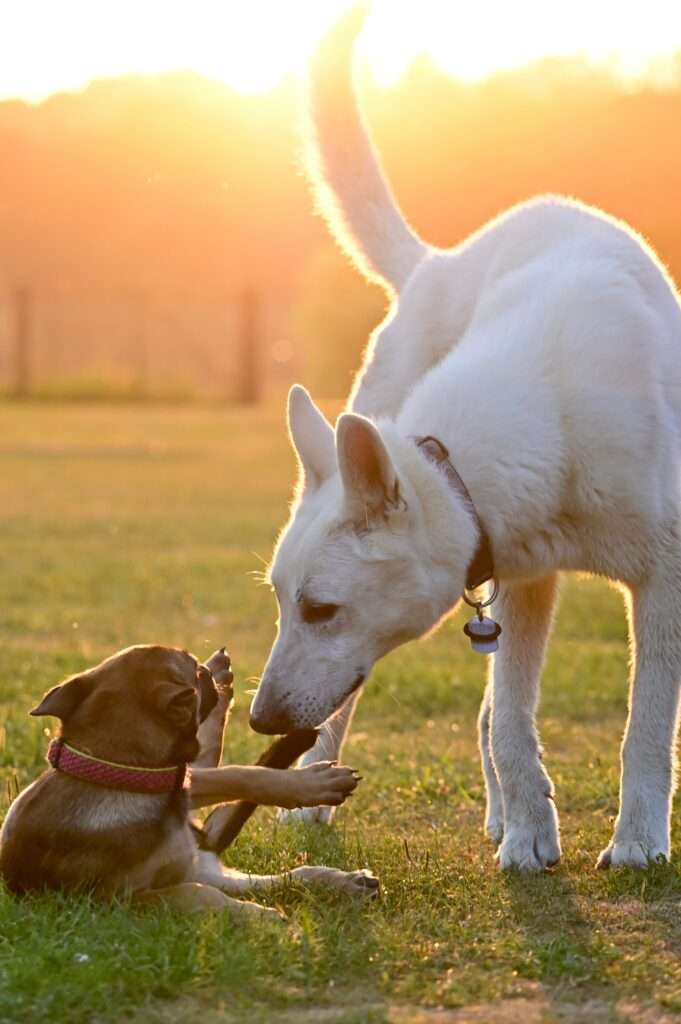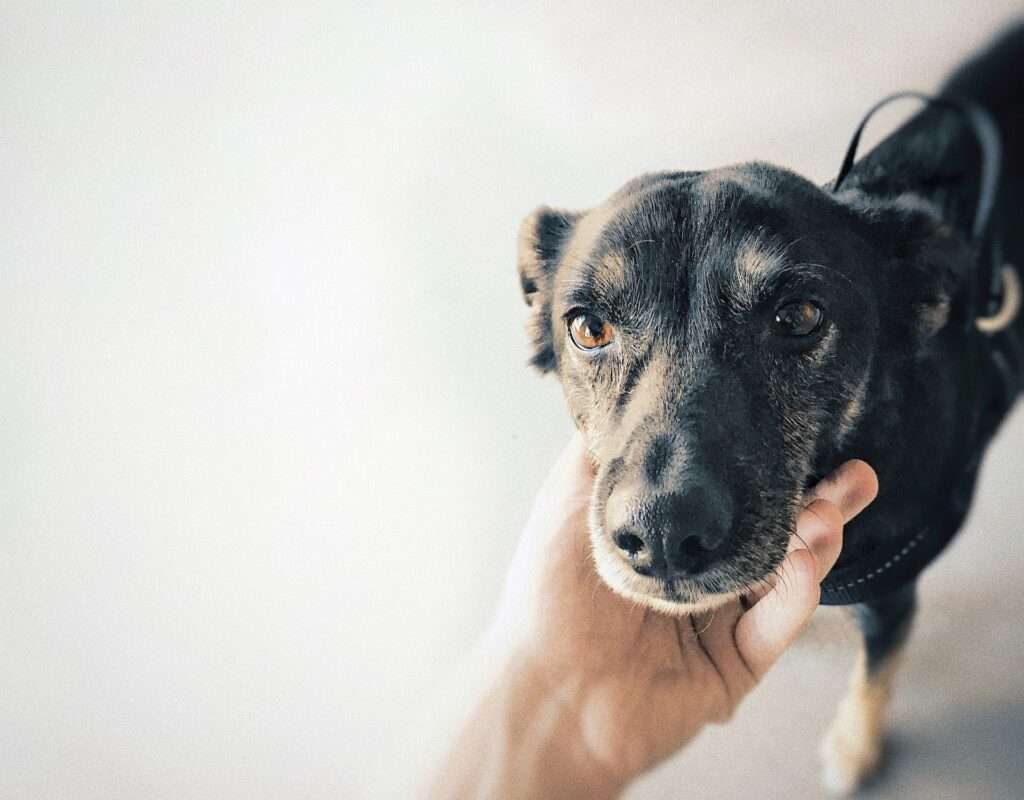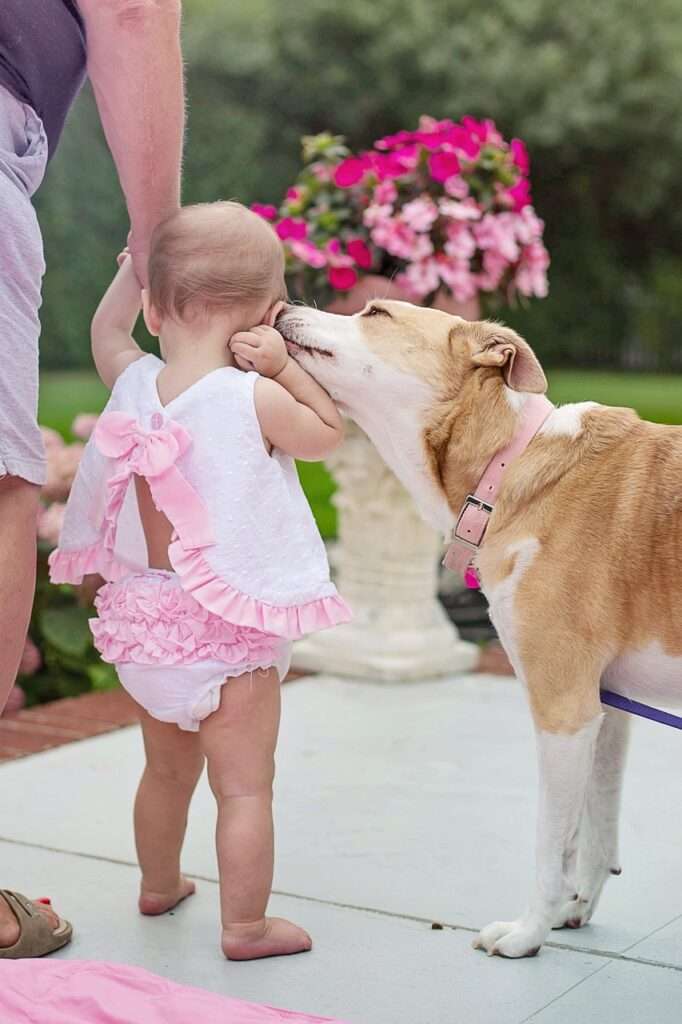Why Does My Dog Nibble My Ear? Playful Insights into Their Behavior
Welcome to the fascinating world of canine behavior, where our furry companions never fail to surprise us with their unique ways of communicating and expressing affection. As devoted dog lovers, we understand that every nose nudge, tail wag, and ear nibble holds a deeper meaning, connecting us with our beloved four-legged friends.
In this comprehensive guide, we will delve into one of the most endearing yet puzzling behaviors of our canine companions: “Why does my dog nibble my ear?” Get ready to explore the science, psychology, and heartfelt stories behind this affectionate gesture. Whether you’re a seasoned pet parent or a new dog owner, we guarantee you’ll gain valuable insights into the world of canine communication.
Exploring Natural Instincts and Social Behavior in Dogs

As the descendants of wolves, dogs have retained certain innate instincts that shape their behaviors even in the modern world. These instincts, honed over centuries, play a crucial role in their interactions with both their fellow canines and us, their beloved human companions.
Communication lies at the heart of understanding these instincts. Dogs communicate through various vocalizations, body language, and, yes, even ear nibbling! Each form of communication carries its own unique meaning, allowing our furry friends to convey their emotions and intentions clearly.
In our daily interactions with dogs, we can witness how they use ear nibbling as a form of expression. Whether it’s a gentle nibble to show affection or a more assertive gesture to communicate dominance, deciphering these subtle cues will deepen the bond between you and your furry pal.
Understanding Canine Communication
Understanding how dogs communicate is the key to nurturing a strong and meaningful bond with our furry companions. Our canine friends have a rich and intricate language of their own, relying on body cues and expressions to convey their emotions and intentions.
Just imagine your dog’s ears perking up at the sound of their name or the gentle nudge they give to seek your attention. These gestures are far from coincidental; they are powerful ways through which dogs communicate and interact with humans and other animals.
As you embark on this enlightening journey of understanding canine communication, pay close attention to tail positions, facial expressions, and body postures. These subtle cues hold profound meanings and provide valuable insights into your dog’s inner world, allowing you to respond with love and care.
The Connection Between Ear-Nibbling and Canine Affection
When your furry friend affectionately nibbles your ear, it’s a heartwarming display of love and trust. Countless instances have shown how ear-nibbling strengthens the deep bond between dogs and their human companions.
Research has shown that dogs release oxytocin, commonly known as the “love hormone,” during positive interactions with humans. Ear-nibbling is a physical gesture that enhances this emotional connection, fostering feelings of warmth and attachment between you and your dog.
For dogs, physical touch is a powerful means of communication, and ear-nibbling is just one of the many ways they express their fondness. As you continue to cherish these precious moments, remember that reciprocating affection through gentle petting and cuddles reinforces the loving bond you share.
Possible Reasons for Ear-Nibbling Behavior
As dog enthusiasts, we understand that every dog’s behavior holds a story, and ear-nibbling is no exception. There are several endearing reasons why your furry companion might engage in this delightful gesture:
- Playfulness and Engagement: Ear-nibbling is often a playful way for dogs to interact with their favorite humans. During playtime, dogs explore different forms of communication, and ear-nibbling may be their way of showing affection and inviting you to join in the fun.
- Seeking Attention and Reassurance: Dogs are social creatures that thrive on human companionship. Ear-nibbling could be their gentle plea for attention and reassurance, as they cherish the comforting touch and closeness they share with you.
- Signs of Submission and Respect: In canine hierarchy, submission is displayed through various gestures, and ear-nibbling can be a respectful way for your dog to acknowledge your authority and show that they value your role as their caregiver.
- Expressing Curiosity and Exploration: Dogs are naturally curious beings, and ear-nibbling might be their way of exploring and getting to know you better. It’s their form of canine communication to understand the world around them and build stronger bonds with their human family.
Remember, each dog is unique, and the reasons behind their ear-nibbling behavior may vary. Understanding their personality and the context in which the behavior occurs will help you decipher the message they’re trying to convey.
Investigating Contextual Cues and Triggers
As passionate pet parents, we encourage keen observation of our dogs’ behavior. Investigating the context in which ear-nibbling occurs can offer valuable insights into why your furry friend engages in this affectionate gesture:
- Daily Routines and Interactions: Notice if ear-nibbling tends to happen during specific times, such as when you return home, during playtime, or right before bedtime. Consistently observing these patterns will help you understand the triggers that lead to this adorable behavior.
- Environmental Influences: Dogs are attuned to their surroundings, and certain stimuli might trigger their affectionate gestures. Whether it’s a particular scent, sound, or visual cue, identifying environmental triggers can provide clues about their emotional state.
- Human Responses: Dogs are remarkably perceptive and can pick up on human emotions and cues. Pay attention to your reactions when your dog nibbles your ear. Positive reinforcement through gentle affection or playtime can encourage this loving behavior.
By investigating contextual cues and triggers, you’ll develop a deeper connection with your furry companion and gain a better understanding of the unique bond you share.
Ear Health and Sensitivity in Dogs
Prioritizing the well-being of our furry companions includes ensuring their ear health. Dogs’ ears are not only adorable but also essential for their sensory perception and balance. Keeping their ears clean and healthy is crucial to ensure their overall happiness and comfort.
- Regular Ear Checks: Make it a habit to inspect your dog’s ears regularly. Look for any signs of redness, swelling, discharge, or foul odor, as these might indicate an ear infection or other health issues. If you notice any abnormalities, consult your veterinarian promptly for proper diagnosis and treatment.
- Cleaning Procedures: Cleaning your dog’s ears should be done with utmost care. Avoid using cotton swabs, as they can push debris deeper into the ear canal. Instead, use veterinarian-approved ear cleaners and gently wipe the outer ear with a soft cloth.
- Ear Sensitivity: Dogs’ ears are highly sensitive, and it’s essential to handle them with care. Avoid excessive touching or rough handling of the ears, as this can cause discomfort or anxiety in your furry friend. Always approach any ear-related activities, such as cleaning, with gentleness and respect for your dog’s comfort levels.
Ensuring a Positive Ear-Nibbling Experience

Creating a positive ear-nibbling experience is essential to nurture the special bond between you and your dog. Here are some tips to make these moments even more enjoyable:
- Establish Trust: Building trust is the foundation of any meaningful relationship. Respect your dog’s boundaries and avoid forcing ear-nibbling if they seem uncomfortable. Let them initiate the gesture to show they feel secure and cherished.
- Training and Positive Reinforcement: Basic training plays a significant role in encouraging desired behaviors. Incorporate positive reinforcement techniques, such as treats or praise, to reward gentle ear-nibbling and discourage rough play.
- Calm and Relaxed Environment: Choose a calm and relaxed setting for ear-nibbling sessions. A peaceful environment helps your dog associate this gesture with tranquility and contentment.
- Bonding Through Touch: Remember that ear-nibbling is just one of the many ways your dog expresses affection. Regular bonding through petting, cuddling, and playtime will deepen your connection and make ear-nibbling even more special.
- Seek Professional Guidance: If your dog’s ear-nibbling behavior becomes excessive or concerning, consider seeking advice from certified dog trainers or behaviorists. They can provide valuable insights and personalized strategies to address any potential issues.
By ensuring a positive ear-nibbling experience, you create a harmonious and loving relationship with your furry friend. Stay tuned for the upcoming chapters, where we’ll explore why ear-nibbling is more than just an affectionate gesture and address when this behavior may be a cause for concern.
When Ear-Nibbling Becomes a Concern
Understanding that every pet parent wants the best for their furry friend, we acknowledge that while ear-nibbling is often an endearing gesture, there are instances where it may become a cause for concern. Here are some scenarios to be mindful of:
- Excessive Aggressiveness: If your dog’s ear-nibbling becomes forceful or aggressive, it’s essential to address this behavior promptly. Aggressive ear-nibbling can indicate underlying issues that may need professional guidance to address.
- Avoidance or Fearful Reactions: Pay attention to your dog’s reaction when you attempt ear-nibbling. If they shy away, show signs of fear, or display other stress-related behaviors, it’s crucial to respect their discomfort and seek advice from a certified dog behaviorist.
- Possessiveness or Resource Guarding: Some dogs may display possessive tendencies during ear-nibbling, guarding the area or exhibiting territorial behavior. This can be problematic and require specialized training to manage effectively.
Remember, each dog is unique, and their ear-nibbling behavior can vary. If you have any concerns about your dog’s ear-nibbling or any other behavior, don’t hesitate to consult a professional to ensure a happy and healthy relationship between you and your furry companion.
The Role of Breed and Individual Personality
Celebrating the incredible diversity among dog breeds and their individual personalities, we recognize that when it comes to ear-nibbling, breed characteristics and personality traits play a significant role in shaping their behavior:
- Breed Influence: Certain breeds are more predisposed to engaging in ear-nibbling due to their history as working or companion animals. For example, herding breeds might exhibit ear-nibbling as a way of directing or corralling.
- Size and Play Style: Larger dogs may appear gentler with their ear-nibbling due to their size, while smaller dogs may be more delicate in their approach. Understanding your dog’s size and play style will help you interpret their ear-nibbling gestures accurately.
- Individual Preferences: Just like humans, dogs have unique personalities and preferences. Some dogs may be more affectionate and enjoy ear-nibbling, while others may not find it as appealing. Respecting your dog’s individuality is vital for a harmonious relationship.
It’s essential to recognize that breed tendencies and individual personalities only provide general insights and not strict rules. Each dog is a product of various factors, and their ear-nibbling behavior is influenced by a combination of genetics, socialization, and environment.
Myths and Misconceptions About Ear-Nibbling

Believing in dispelling myths and providing accurate information to foster responsible pet ownership, we address several myths and misconceptions surrounding ear-nibbling behavior:
- Aggressive Behavior: One common misconception is that ear-nibbling is always a sign of aggression. In reality, ear-nibbling can be a playful and affectionate gesture when done gently and in a relaxed context.
- Dominance Display: Some believe that ear-nibbling is a dominant behavior. While dogs may engage in ear-nibbling as a form of respect, it’s more often an expression of affection and bonding.
- Teething Behavior: Another myth suggests that puppies nibble ears during teething. While puppies may explore the world with their mouths, teething behavior is distinct from ear-nibbling and requires appropriate teething toys and training.
- Attention-Seeking Behavior: Ear-nibbling can indeed be a way for dogs to seek attention, but it is not necessarily a manipulative or negative behavior. Dogs crave companionship and may use ear-nibbling as a gentle request for interaction.
Understanding the true nature of ear-nibbling helps build a more compassionate and informed relationship with our canine friends. Let’s continue to cherish these heartwarming moments and celebrate the joy of canine communication.
Heartwarming Stories: Ear-Nibbling Experiences from Dog Owners
Nothing warms our hearts more than the tales of love and connection between dogs and their human families. We’ve had the privilege of witnessing countless heartwarming ear-nibbling experiences shared by our community of devoted dog owners, each story a testament to the unbreakable bond between our furry friends and their cherished human companions:
Sarah and Max
Sarah, a first-time dog owner, was initially puzzled when her adorable Golden Retriever, Max, started nibbling her ear. After researching and consulting a trainer, she realized that Max used this gesture to express his affection and trust. Today, Sarah and Max’s ear-nibbling sessions are moments of pure joy and bonding.
Mark and Luna
Mark’s rescue dog, Luna, came with a history of fear and anxiety. As Luna gradually opened up to her new home, Mark noticed her timid ear-nibbling whenever she sought comfort. Through patience and love, Luna’s ear-nibbling evolved into a beautiful expression of her growing confidence and happiness.
Emily and Cooper
Emily’s mischievous Beagle, Cooper, became famous in their neighborhood for his playful ear-nibbling antics. From kids to seniors, Cooper’s ear-nibbling brought smiles and laughter to everyone he met. His endearing gestures showed that love knows no boundaries.
These heartwarming stories demonstrate the profound bond that ear-nibbling fosters between dogs and their human companions. Each story is a reminder of the unique ways dogs communicate their love and affection.
Conclusion
As we wrap up our journey into the heartwarming world of canine communication and ear-nibbling, we hope you’ve gained a deeper appreciation for the unique ways our furry friends express their love and affection. At BarkLikeMeow, we firmly believe that understanding our dogs’ behaviors enriches the bonds we share, making every moment spent together even more special.
Ear-nibbling, with its playful charm and genuine warmth, is just one of the many ways our dogs communicate with us. From their joyful tail wags to their soulful eyes, each gesture carries a meaningful message that we, as pet parents, can cherish and reciprocate.
Through this comprehensive guide, we’ve explored the natural instincts and social behaviors that make ear-nibbling an integral part of canine communication. We’ve debunked myths and misconceptions, empowering you to interpret your dog’s gestures with clarity and compassion.
Remember, every dog is a unique individual, shaped by their breed tendencies, personalities, and life experiences. Embrace their uniqueness, and celebrate the joy of discovering their individual ways of expressing love. Here’s to the enduring and unbreakable bond between dogs and their devoted human companions!
Frequently Asked Questions
Q: Why does my dog nibble my ear?
A: Dogs nibble ears as a way to show affection and establish social bonds. It’s a natural behavior rooted in their evolutionary past as pack animals.
Q: Is ear-nibbling a sign of dominance or aggression?
A: Not necessarily. Ear-nibbling in most cases is an expression of love and trust. However, if done aggressively, it could indicate other issues that may need professional guidance.
Q: Should I allow my dog to nibble my ear?
A: If your dog’s ear-nibbling is gentle and affectionate, it’s generally safe and enjoyable for both of you. However, if you or your dog are uncomfortable with the behavior, it’s best to set boundaries and redirect their attention to other positive interactions.
Q: What if my dog doesn’t nibble my ear at all?
A: Not all dogs display the same behaviors. Some may prefer other forms of affection, like cuddling or licking. The key is to understand and respect your dog’s individual preferences for bonding.
Q: Can ear-nibbling be harmful to my dog’s health?
A: Generally, ear-nibbling itself is not harmful. However, it’s crucial to ensure your dog’s ears are clean and free from any potential health issues to avoid discomfort or infection.
Q: How can I encourage positive ear-nibbling experiences?
A: Building trust through positive reinforcement, gentle affection, and providing a calm and relaxed environment can foster positive ear-nibbling interactions with your dog.
Q: My dog nibbles my ear excessively. Should I be concerned?
A: Excessive ear-nibbling might indicate underlying issues such as anxiety or stress. It’s essential to observe your dog’s overall behavior and consult a veterinarian or certified dog behaviorist if you have any concerns.
Q: Can I train my dog to stop ear-nibbling if I find it uncomfortable?
A: Yes, with proper training and positive reinforcement techniques, you can redirect your dog’s behavior and set boundaries for ear-nibbling, ensuring a more comfortable and enjoyable interaction for both of you.




